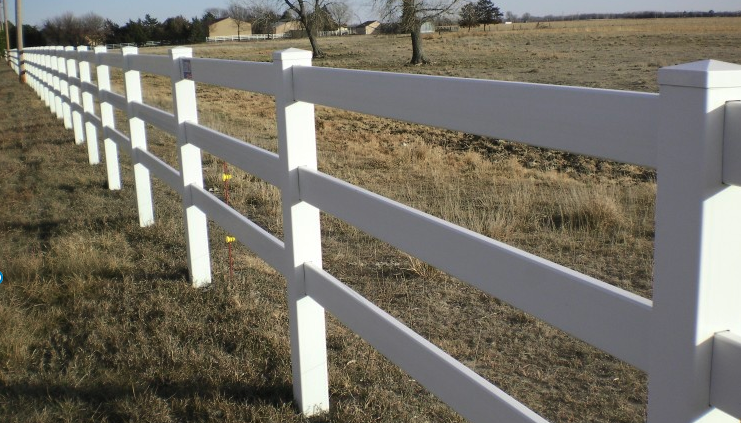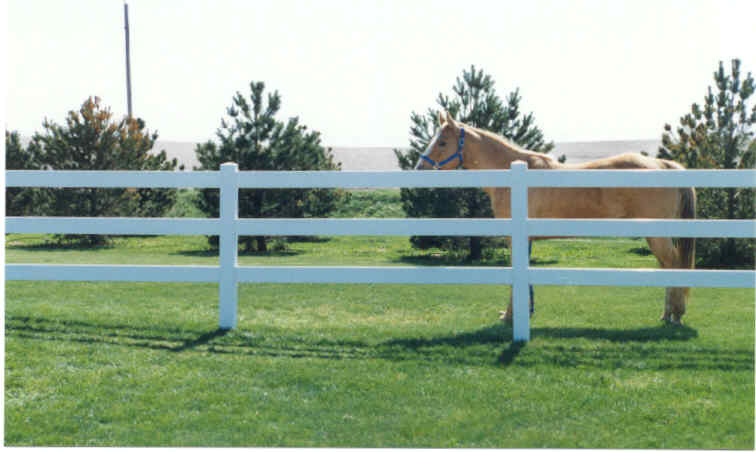The Beauty and Benefits of Vinyl Ranch Rail Fencing

In centuries past, the general purpose of installing a fence in North America was more to mark the perimeter of one’s land rather than to protect it. To distinguish perimeters and save money at the same time, farmers and ranchers typically resorted to ranch rail fencing—favoring this particular barrier for its simplistic, economic design. Composed primarily of elongated rails—with spacious gaps in between—these panels required less lumber to build and could be constructed without professional assistance. The same principles apply today, which is why ranch rail fencing remains a common installation at farms, ranches, cabins, and country homes. Railed barriers are frequently used for fencing in livestock as the animals cannot so easily become trapped in the panels (they won’t so easily get their hoof stuck as can happen with, say, the gaps in a chain link fence.)
Also known as split rail fencing, ranch rail was once an exclusive wood product. Nowadays, many contractors specialize in ranch rail made of vinyl—the kind we at American Fence Company personally recommend! Providing the same attractive aesthetics and property-marking functions as wood, PVC ranch rail fencing also boasts some benefits unique to its structural integrity and longevity.
FOR A FREE ESTIMATE:
What are the benefits of vinyl vs. wood regarding ranch rail fencing?
Since wood fence panels have a proven history of marking property lines, why even consider a vinyl version of the same product? In short: PVC is the superior material—longer-lasting, resilient to the factors that cause wood to warp or deteriorate, and less costly in the long run.
- Resistance to water damage. One of the drawbacks of wood fencing is preventing those unsightly deformations that occur due to long-term exposure to water. When your fence becomes drenched with rain, melting snow, overspray from a garden hose, etc., the water absorbs into the wood and expands/contracts inside in accordance with temperature changes. During winter, for example, the trapped liquids freeze into ice, metastasizing and pushing apart the inner foundation of the wood as it does. Depending on the severity, the end result can encompass cracks, bulges, and even split boards.
To avoid this issue, most fence owners resort to painting and staining (and sometimes re-staining) their fences each year. This helps keep water trapped on the surface of the wood but, in the long run, adds to your expenses. Painting and staining each year results in accumulating expenses that can be avoided simply by constructing your ranch rail fence out of water-resistant materials such as vinyl. As a nonabsorbent material, vinyl simply runs off the water that comes in contact with it.

FOR A FREE ESTIMATE ON RANCH RAIL FENCING:
- Superior strength. Even if the purpose of installing your fence is to mark outlines versus safeguarding property, you’ll want one composed of durable, long-lasting material. (After all, the more fence panels that become damaged, the more you’ll end up paying for repairs/replacements.) This is another advantage of opting for PVC vs. wood. A high-quality vinyl fence boasts strength five times that of its wood counterpart—meaning greater resilience to everyday impacts. This is one of the reasons split rail remains a common choice for cattle farms: even when livestock brushes against the PVC, the rails and posts remain sturdy and in place.
The strength of vinyl endures even with significant changes in temperature. The only significant change you’ll notice in the freezing grip of winter is increased flexibility in your fence panels. And even then, the panels themselves shouldn’t break unless subjected to a significant amount of force (say, an automobile crash).
- Long-lasting beauty. Vinyl ranch rail fencing remains in demand nationwide primarily for its breathtaking aesthetics. And what’s particularly great about PVC is that it retains natural beauty much longer than other fence types. In addition to its resilience to chipping and cracks, your fence will retain its original color—the only natural change over time consisting of a slight reduction on its natural sheen.
- Resistance to insect damage. Another potential hazard wood fence owners contend with are termites, carpenter ants, and similar insect species which gorge on trees and tree products. Vinyl, however, is not on the menu for these pesty wood-munchers. So when you set up a PVC ranch rail fence around your farm or ranch, you don’t have to worry about insect-related damage.
Where can I buy materials to build a vinyl ranch rail fence?
As alluded to at the beginning of this article, one of the historical reasons behind split rail fencing’s enduring popularity is easy construction. These fence panels can be put together by an ambitious DIY homeowner, and in the hands of experienced industry professionals—like those employed here at American Fence Company—a fence can be assembled in a matter of days or even hours! But regardless of whether you hire a contractor or build the fence yourself, you need assurance that your fence will be made of high-quality PVC.
Don’t settle for the cheap, flimsy stock available at the big box stores. Reach out to a reputable fence contractor that goes the extra mile in acquiring top-level materials. American Fence Company, for instance, also sells vinyl fence parts in addition to building fences for our customers. And to ensure that we use—and sell—only the best, we’ve forged lasting partnerships with reputable vinyl manufacturers such as Ply Gem & Rail.